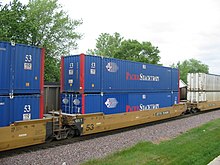Articulated vehicle: Difference between revisions
Autoreplete (talk | contribs) m →Military vehicles: Added Logistics Vehicle System. |
|||
| Line 31: | Line 31: | ||
===Military vehicles=== |
===Military vehicles=== |
||
Some military vehicles, including the US military [[Gama Goat|M561 Gama Goat]] |
Some military vehicles, including the US military's [[Gama Goat|M561 Gama Goat]] and [[Logistics Vehicle System]] were engineered with an articulated body for rough terrain capability. |
||
==See also== |
==See also== |
||
Revision as of 07:11, 12 May 2015


An articulated vehicle is a vehicle which has a permanent or semi-permanent pivoting joint in its construction, allowing the vehicle to turn more sharply. There are many kinds of articulated vehicles, from heavy equipment to buses, trams and trains. Steam locomotives were sometimes articulated in that the driving wheels could pivot around turns.
In a broader sense, any vehicle towing a trailer could be described as articulated (the word articulated comes from the Latin articulus : small joint). In the UK, the term "articulated lorry" refers to the combination of a tractor and a semi-trailer, abbreviated to "artic". In the U.S., this is called a semi-trailer truck, "tractor-trailer" or "semi-truck" and would not necessarily be called articulated.
Type of vehicles



Buses
Buses are articulated to allow for a much longer bus which can still navigate within the turning radius of a normal bus.
Trucks
In the UK, semi-trailers on tractor units are referred to as "articulated lorries".
Trains and rail
Many train cars are made with articulated connections, sharing a common truck between two cars. This reduces costs, weight, vibration and noise; and also enables higher speed running. One of the first examples of articulated railway carriages were used by London and North Eastern Railways in Great Britain on their London Suburban Trains in the mid-1920s ; these trains (rolling stock) were designed by Sir Nigel Gresley and built at the LNER's Doncaster Works. The four set "Quad-arts" were one of the very earliest articulated trains, this innovation was to save space. Although not the same as modern high speed trains where all the carriages share common bogies, they are an early form of the now more common design.
Trams and Light Rail Vehicles have been made with articulated designs since the 1950s. This was instead of using trailers or multiple units, which had been attempted in the early 1900s. The articulated design allows passengers (and fare inspectors) to move the entire length of the vehicle, whether stopped or in motion.
Heavy equipment
Front loaders, graders, dump trucks and other vehicles have been made with articulated joints to greatly reduce their turning radius. The most common models of articulated haulers are Caterpillar, Volvo, and Terex trucks ranging in tonnage from 25 to 40 ton.
Military vehicles
Some military vehicles, including the US military's M561 Gama Goat and Logistics Vehicle System were engineered with an articulated body for rough terrain capability.
